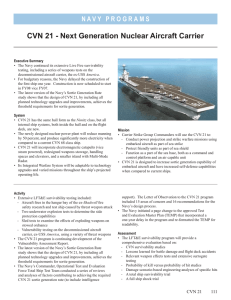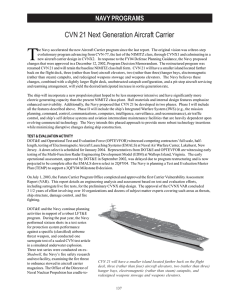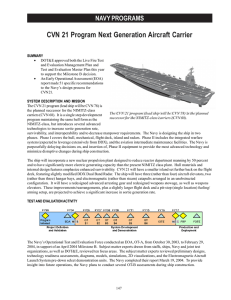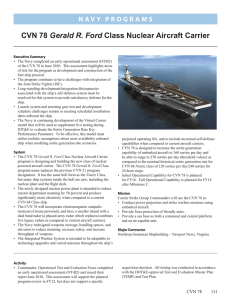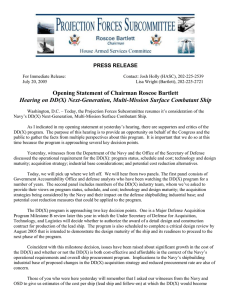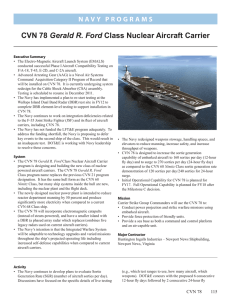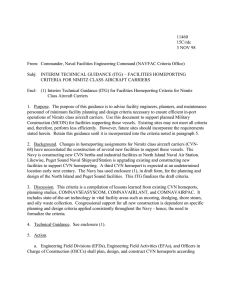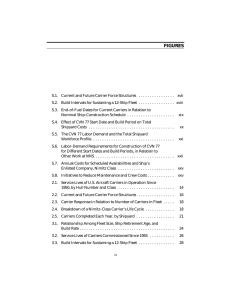CVN 21 – Next Generation Nuclear Aircraft Carrier
advertisement
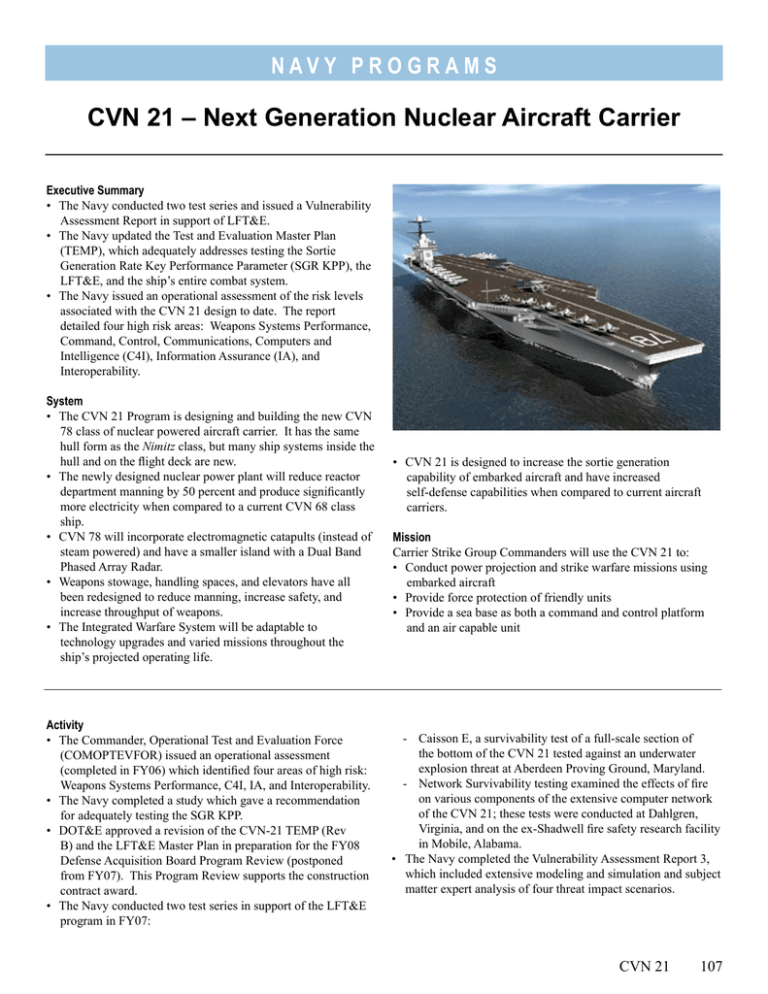
N av y P R O G R A M S CVN 21 – Next Generation Nuclear Aircraft Carrier Executive Summary • The Navy conducted two test series and issued a Vulnerability Assessment Report in support of LFT&E. • The Navy updated the Test and Evaluation Master Plan (TEMP), which adequately addresses testing the Sortie Generation Rate Key Performance Parameter (SGR KPP), the LFT&E, and the ship’s entire combat system. • The Navy issued an operational assessment of the risk levels associated with the CVN 21 design to date. The report detailed four high risk areas: Weapons Systems Performance, Command, Control, Communications, Computers and Intelligence (C4I), Information Assurance (IA), and Interoperability. System • The CVN 21 Program is designing and building the new CVN 78 class of nuclear powered aircraft carrier. It has the same hull form as the Nimitz class, but many ship systems inside the hull and on the flight deck are new. • The newly designed nuclear power plant will reduce reactor department manning by 50 percent and produce significantly more electricity when compared to a current CVN 68 class ship. • CVN 78 will incorporate electromagnetic catapults (instead of steam powered) and have a smaller island with a Dual Band Phased Array Radar. • Weapons stowage, handling spaces, and elevators have all been redesigned to reduce manning, increase safety, and increase throughput of weapons. • The Integrated Warfare System will be adaptable to technology upgrades and varied missions throughout the ship’s projected operating life. Activity • The Commander, Operational Test and Evaluation Force (COMOPTEVFOR) issued an operational assessment (completed in FY06) which identified four areas of high risk: Weapons Systems Performance, C4I, IA, and Interoperability. • The Navy completed a study which gave a recommendation for adequately testing the SGR KPP. • DOT&E approved a revision of the CVN-21 TEMP (Rev B) and the LFT&E Master Plan in preparation for the FY08 Defense Acquisition Board Program Review (postponed from FY07). This Program Review supports the construction contract award. • The Navy conducted two test series in support of the LFT&E program in FY07: • CVN 21 is designed to increase the sortie generation capability of embarked aircraft and have increased self‑defense capabilities when compared to current aircraft carriers. Mission Carrier Strike Group Commanders will use the CVN 21 to: • Conduct power projection and strike warfare missions using embarked aircraft • Provide force protection of friendly units • Provide a sea base as both a command and control platform and an air capable unit - Caisson E, a survivability test of a full-scale section of the bottom of the CVN 21 tested against an underwater explosion threat at Aberdeen Proving Ground, Maryland. - Network Survivability testing examined the effects of fire on various components of the extensive computer network of the CVN 21; these tests were conducted at Dahlgren, Virginia, and on the ex-Shadwell fire safety research facility in Mobile, Alabama. • The Navy completed the Vulnerability Assessment Report 3, which included extensive modeling and simulation and subject matter expert analysis of four threat impact scenarios. CVN 21 107 N av y P R O G R A M S Assessment • The updated TEMP (Rev B) now adequately addresses testing of the SGR KPP and testing of the entire ship warfare system. - The number of live flight days recommended in the Navy SGR study is acceptable only if the Navy continues to develop and properly validate the models it used as a design aid for the ship. The validated models, in conjunction with the live flight days, should be enough to adequately test the KPP. - The Navy decided to develop the Threat D target. This target will be required to adequately test the ship self‑defense capabilities. • Due to the level of maturity of CVN 21 lead ship design (IOT&E is not scheduled until FY16), the operational assessment conducted by COMOPTEVFOR consisted primarily of government and contractor briefings to subject matter experts. The design concept for the ship consisted of two phases. The high risk areas identified by COMOPTEVFOR (Weapons Systems Performance, C4I, IA, and Interoperability) are covered mainly in Phase Two where design has just started. • The Electromagnetic Aircraft Launch System (EMALS) will be tested at the Naval Air Station in Lakehurst, New Jersey. If EMALS equipment design as installed at the System Development and Demonstration test site continues to diverge 108 CVN 21 from the ship design, EMALS installation and integration may require additional testing. • The comprehensive CVN 21 LFT&E plan is now based on: - CVN survivability studies - Lessons learned from battle damage and flight deck accidents - Relevant weapon effects tests - Extensive surrogate testing - Probability of kill versus probability of hit studies - Damage scenario-based engineering analyses of specific hits - A total ship survivability trial - A full ship shock trial Recommendation • Status of Previous Recommendations. All previous recommendations have been adequately addressed. • FY07 Recommendations. The Navy should: 1. Place an emphasis on the Phase Two systems during the FY08 operational assessment. 2. Evaluate ways to test EMALS that more closely duplicates the ship installation or evaluate ways to perform extended pier side testing of the ship set before risking manned aircraft.

